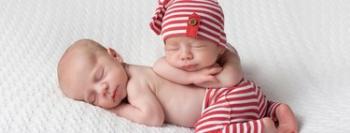

TWINS
18/12/2019
About 25% of identical twins are the strange phenomenon of mirror twins, babies in whom we find the same characteristics but with the opposite character, inverse symmetry, as if they were reflected in a mirror. For example, if one is left-handed, the other is right-handed, if one swirls the hair to one side, the other to the opposite side ...
Sometimes we can get to see really peculiar cases in which the organs also share this symmetry.
How do twins form in a mirror?
The phenomenon of mirror twins occurs between identical or monozygotic (or univiteline) twins, babies that arise from the fertilization of an egg and sperm that form a zygote and then this zygote divides to form two embryos.
In Babies and more
Twins and twins, what's the difference?
Depending on the moment in which the zygote is divided, it gives rise to different types of twins:
• Bicorials and biamnióticos: it is divided within the first 3 days after fertilization. Each embryo grows inside its own amniotic bag and feeds on its own placenta.
• Monocorials and biamniotics: the division of the zygote occurs between the fourth and seventh day after fertilization. They share placenta but not amniotic bag. They represent 90% of monozygotic twin pregnancies.
• Monocorial and monoamniotic: these are very rare cases. It happens when the division of the zygote occurs late, between 7 and 13. day after fertilization. They share placenta and amniotic bag.
Among the latter are the mirrored twins, the result of a late division of the zygote around 9-12 days, when the right and left side of the embryo is already decided, and when divided, a twin will be the reflection of the first .
The funny thing is that if the division of the zygote occurs beyond the 13th, it is the case of Siamese or united twins, brothers who are united by some part of their bodies (thoracophagous, united by the thorax; pigópagos, united by the buttocks and craniopagos, joined by the head).
In Babies and more
Probabilities of having twins
The case of the mirror twins Lucas and Louise
Lucias and Louise Cooke are two 22-month-old babies who are twins in the mirror. They shared amniotic sac and were born with interlaced cords, but also their heart, liver and spleen are on opposite sides of their bodies, which occurs in extreme cases of the twins in mirror image and is known as "situs inversus", which is given in one case every 10,000.
In mirror twins, different degrees of symmetry can occur, from physical characteristics such as hair, marks, moles, bite, to inverse organs such as these little ones. Doctors mentioned that if they separated two days later, Cooke twins would have been Siamese twins joined by their organs.
Although one of the children has a heart defect known as CCTGA in which the lower half of the heart is reversed, this condition does not cause any problems and only forces him to have annual checkups. Despite having the organs in a mirror, this does not involve any complications.
Evanescent Twin Syndrome
One of the theories that evanescent twin syndrome throws up, in which one of the embryos stops developing and is absorbed by the mother, by the placenta or even by the other brother, is that left-handed people could be the result of pregnancy. mirror twin in which the other twin, the right-handed, did not develop.
Without a doubt, the formation of the human being is a fascinating mystery that never ceases to surprise us.
In Babies and more | "In the womb: identical twins": the documentary about the development of equal twins















